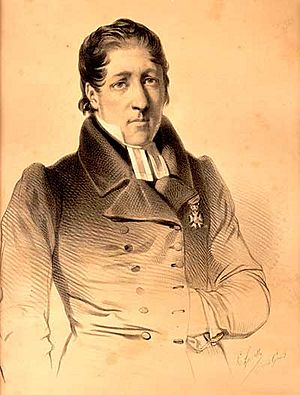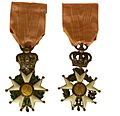Lars Levi Laestadius facts for kids
Quick facts for kids
Lars Levi Laestadius
|
|
|---|---|

Laestadius in 1839
|
|
| Born | 10 January 1800 Jäckvik, Arjeplog, Sweden
|
| Died | 21 February 1861 (aged 61) Pajala, Norrbotten, Sweden
|
| Occupation |
|
Lars Levi Laestadius (10 January 1800 – 21 February 1861) was a Swedish Sami pastor. He worked for the Church of Sweden in Lapland. He started a Christian movement called Laestadianism. This movement helped his Sami church members, who were facing many problems.
Laestadius was also a well-known botanist, someone who studies plants. He was also a writer.
Contents
Early Life and Learning
Birth and School Days
Lars Levi Laestadius was born in 1800 in Jäckvik, Sweden. His parents were of Sami background. Lars Levi and his younger brother Petrus didn't have much money. But their older half-brother, Carl Erik Laestadius, helped them. Carl Erik was also a pastor.
The brothers lived with Carl Erik for part of their childhood. This help allowed them to go to school. They first studied in Härnösand. Then, in 1820, they went to Uppsala University. Even though they often didn't have much money, Lars Levi was a very smart student. He loved studying plants. Because of this, he became an assistant in the plant science department. At the same time, he studied theology, which is the study of religious faith.
Lars Levi Laestadius became a Lutheran priest in 1825. He was ordained by the bishop of Härnösand.
Marriage and Family Life
In 1827, Laestadius married Brita Katarina Alstadius. She was a Sami woman from his hometown and a childhood friend. They had twelve children together. Sadly, at least two of their children died when they were young.
Laestadius's Church Work and New Movement
Places He Served
Laestadius's first church job was in Arjeplog, Lapland. He became a missionary for the Pite area. From 1826 to 1849, he was the main pastor in Karesuando parish in Lapland.
Later, Laestadius applied for new jobs in Pajala parish. He wanted to be the dean and an inspector for the Lapland churches. After passing more exams, he took these jobs in 1849. He worked there until he died in 1861.
The Revival Movement Begins
Laestadius's Important Meeting
In 1844, Laestadius met a Sami woman named Milla Clementsdotter. She was also known as Lapp Mary. This meeting happened during a trip to Åsele in Lapland. Milla belonged to a Christian movement that focused on personal faith.
She told Laestadius about her own journey to a strong faith. This meeting was very important for Laestadius. He later said that after talking to her, he finally understood what "living faith" truly meant. He had a powerful religious experience. He wrote that he finally saw the way to eternal life.
After this, his sermons changed. He said they had "a new kind of colour." People started to listen and respond. This new movement quickly spread from Sweden to Finland and Norway. Laestadius based all his sermons on the Bible.
How It Changed People
People noticed that Laestadius had changed. His sermons used clear examples from Sami life. These examples were easy for them to understand. He spoke about a God who cared deeply about people's lives. He also spoke out against priests and traders. These people were making money by taking advantage of others.
After twenty years, something new was happening between the pastor and his church members. Both young and old wanted to learn to read. There was also a lot of energy in the church. People would confess their sins. They would cry and pray for forgiveness. This was sometimes called liikutuksia, a kind of strong emotion.
Not everyone liked these changes. Those who made money selling alcohol saw their income disappear. They made fun of the new ways. But drunkenness and reindeer theft went down. This helped improve Sami relationships, money, and family life.
Facing Challenges
When Laestadius moved to Pajala in 1849, some people resisted his strong Christian rules. They didn't like how he confronted people about their sins. In 1853, the bishop decided to hold two separate church services. One was for the Laestadians, and one was for others.
This is when Laestadianism became its own distinct movement. However, it always remained part of the Church of Sweden. It never fully separated.
Why Laestadianism Grew Among the Sami
The Laestadian movement grew quickly among the Sami people for several reasons. Laestadius was proud to be Southern Sami through his mother. He spoke and preached in two Sami dialects. He also chose ordinary Sami reindeer herders as preachers. These preachers traveled with the herders all year. They shared the message with those who had not yet changed their ways.
In the early days, Laestadius used some Sami traditional ideas. He changed them to fit Christian teachings. This helped him connect with his church members. Also, the government-run boarding schools soon had Laestadian staff.
The strict rules of Laestadianism, especially about not drinking alcohol, appealed to the Sami. This also helped improve the Sami's standing with people outside their community. Finally, the Sami felt that Laestadianism came from within their own culture. Laestadius himself said he found true faith only after meeting Milla Clementsdotter, a Sami woman.
Who Took Over
When Laestadius died in 1861, Johan Raattamaa became the new leader of the Laestadian movement.
Botanist and Plant Expert
Laestadius went on his first plant study trip as a student. Later, the Royal Swedish Academy of Sciences paid him to travel. He went to Skåne in southern Sweden and to Lapland. His job was to study plants and draw them. These drawings were used in Swedish plant science work.
He was known around the world as a botanist. He was a member of the Edinburgh Botanical Society. He was also part of the Royal Society of Sciences in Uppsala.
Several plant species have been named after Laestadius. For example:
- Salix laestadiana
- Carex laestadii
- Papaver laestadianum
Laestadius also named many plant species himself. You can find a list of plants he named here: List of plants named by Laestadius in IPNI
The La Recherche Expedition (1838-1840)
While working as a pastor, Laestadius kept up his interest in plants. He wrote many articles about plant life in Lapland. Because he knew so much about plants and the Sami people, the French Navy invited him to join an expedition. This was the La Recherche Expedition to Samiland from 1838 to 1840.
As part of the expedition, Laestadius was a guide. He helped explore the islands and inland areas of Northern Norway and Sweden. He studied both the plants and the culture of the Sami people living there.
During the expedition, Laestadius started writing a book. The organizers asked him to do this. This book, Fragments of Lappish Mythology, was finally published over 150 years later. It shows what Sami traditional religious beliefs were like in the 1830s. These beliefs were fading away as the Church of Sweden spread Christianity. Laestadius did not finish the book until much later. The finished book was lost for many years. Because of this, it was not published until 1997.
For his work on the La Recherche Expedition, Laestadius received an award. It was the Medal of Honor of the Legion of Honor of France. He received it after 1841. He was the first person from Scandinavia to get this special award.
Languages He Spoke
Laestadius's first languages were Southern Sami, from his mother, and Swedish, from his father. He also spoke Pite Sami. After living in Karesuando for a year, Laestadius learned Finnish and Northern Sami. He usually held his church services in Finnish. This was because it was the most common language in the area. But sometimes, he also preached in Northern Sami and Swedish.
Books He Wrote
- Fragments of Lappish Mythology (1997) ISBN: 0-9685881-9-0
- The Voice of One Crying in the Wilderness (A Periodical Published in the Years 1852-1854) (in Swedish, Ens ropandes röst i öknen 1852-1854)
Images for kids
-
Medal of honor of the Legion of Honor of France after 1841.
See also
 In Spanish: Lars Levi Laestadius para niños
In Spanish: Lars Levi Laestadius para niños
- La Recherche Expedition (1838–1840)
- Læstadiuspörtet
- Native American temperance activists


